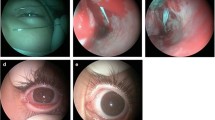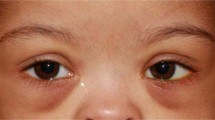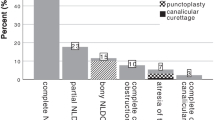Abstract
Background
One of the indications for dacryocystorhinostomy (DCR) in children with congenital nasolacrimal duct obstruction (CNLDO) is failure of silicone intubation. We evaluated the course of epiphora after failure of silicone intubation for CNLDO when DCR was not performed.
Methods
In a comparative cohort study carried out at a tertiary referral center, ten eyes of seven consecutive children who had failure of silicone intubation manifested as persistent epiphora over 2 months and whose parents refused DCR were followed up for an average of 50.4 months (range 33–70 months). Three lacrimal drainage systems of three other children who had failure of silicone intubation underwent uneventful DCR.
Results
In eight (80%) of the ten consecutive eyes with congenital nasolacrimal duct obstruction (six of the seven children, 86%), there was spontaneous complete resolution of the epiphora and normal dye disappearance test (DDT) at the end of the follow-up period. One child with Down’s syndrome, allergic rhinitis, asthma and multiple site obstructions had improvement of symptoms but abnormal DDT. The epiphora in all three children who underwent DCR had disappeared by 6 months after surgery when the silicone tube was removed. No complications were noted during the follow-up.
Conclusions
Epiphora can spontaneously resolve after failure of silicone intubation in CNLDO, and DCR should no longer considered be compulsory in such cases unless complications evolve.
Similar content being viewed by others
References
Aggarwal RK, Misson GP, Donaldson I, Willshaw HE (1993) The role of nasolacrimal intubation in the management of childhood epiphora. Eye 7:760–762
Baker JD (1985) Treatment of congenital nasolacrimal duct system obstruction. J Pediatr Ophthalmol Strabismus 22:34–36
Dortzbach RK, France TD, Kushner BJ, Gonnering RS (1982) Silicone intubation for obstruction of the nasolacrimal duct in children. Am J Ophthalmol 94:585–590
El-Mansoury J, Calhoun JH, Nelson LB, Harley RD (1986) Results of late probing for congenital nasolacrimal duct obstruction. Ophthalmology 93:1052–1054
Gunton KB, Chung CW, Schnall BM et al (2001) Comparison of balloon dacryocystoplasty to probing as a primary treatment of congenital nasolacrimal duct obstruction. J AAPOS 5:139–142
Hakin KN, Sullivan TJ, Sharma A, Welham RAN (1994) Pediatric dacryocystorhinostomy. Aust NZ J Ophthalmol 22:231–235
Katowitz JA, Welsh MG (1997) Timing of initial probing and irrigation in congenital nasolacrimal duct obstruction. Ophthalmology 94:698–705
Leone CR, Van Gemert JV (1989) The success rate of the silicone intubation in congenital nasolacrimal duct obstruction. Ophthalmic Surg 5:43–48
MacCwen GJ, Young JDH (1991) Epiphora during the first year of life. Eye 5:596–600
Maini R, MacEwen CJ, Young JDH (1998) The natural history of epiphora in childhood. Eye 12:669–671
Mannor GE, Frimpong-Ansah K, Ezra E (1999) Factors affecting the success of nasolacrimal duct probing for congenital nasolacrimal duct obstruction. Am J Ophthalmol 127:616–617
Migliori ME, Putterman AM (1988) Silicone intubation for the treatment of congenital nasolacrimal duct obstruction: successful results removing the tubes after six weeks. Ophthalmology 95:792–795
Munk PL, Lin DT, Morris DC (1990) Epiphora: treatment by means of dacryocystoplasty with balloon dilation of the nasolacrimal drainage apparatus. Radiology 177:687–690
O’Donnell BA, Adenis JP, Linberg JV, Rose GE, Sullivan TJ, Wobig JL (2001) The failed probing. Clin Exp Ophthalmol 29:276–280
Older J (1988) Congenital nasolacrimal duct obstruction. In: Linberg J (ed) Lacrimal surgery. Churchill Livingstone, London
Paul TO (1985) Medical management of congenital nasolacrimal duct obstruction. J Pediatr Ophthalmol Strabismus 22:68–70
Robb RM (1998) Success rates of nasolacrimal duct probing at intervals after 1 year of age. Ophthalmology 105:1307–1310
Robb RM (2001) Congenital nasolacrimal duct obstruction. Ophthalmol Clin North Am 14:443–446
Stager D, Baker JD, Frey T et al (1992) Office probing of congenital nasolacrimal duct obstruction. Ophthalmic Surg 23:482–484
Tan AD, Rubin PAD, Sutula FC, Remulla HD (2001) Congenital nasolacrimal duct obstruction. Int Ophthalmol Clin 41:57–69
Wagner RS (2001) Management of congenital nasolacrimal duct obstruction. Pediatr Ann 30:481–488
Welham RAN, Henderson RH (1973) Results of dacryocystorhinostomy analysis of cases for failure. Trans Ophthalmol Soc U K 93:601–609
Welham RAN, Hughes SM (1985) Lacrimal surgery in children. Am J Ophthalmol 99:27–34
Welsh MG, Katowitz JA (1989) Timing of silastic tubing removal after intubation for congenital nasolacrimal duct obstruction. Ophthalmic Plastic Reconstr Surg 5:43–48
Wesley RE (1985) Inferior turbinate fracture in the treatment of congenital nasolacrimal duct obstruction and congenital nasolacrimal duct anomaly. Ophthalmic Surg 16:368–371
Zappia RJ, Milder B (1972) Lacrimal drainage function. 2. The fluorescence dye disappearance test. Am J Ophthalmol 74:160–162
Zwaan J (1997) Treatment of congenital nasolacrimal duct obstruction before and after the age of 1 year. Ophthalmic Surg Lasers 28:932–936
Author information
Authors and Affiliations
Additional information
The authors have no financial or proprietary interest in any of the products mentioned in this paper.
Rights and permissions
About this article
Cite this article
Kassif, Y., Rehany, U., David, M. et al. The course of epiphora after failure of silicone intubation for congenital nasolacrimal duct obstruction. Graefe's Arch Clin Exp Ophthalmol 243, 758–762 (2005). https://doi.org/10.1007/s00417-004-1115-4
Received:
Revised:
Accepted:
Published:
Issue Date:
DOI: https://doi.org/10.1007/s00417-004-1115-4




